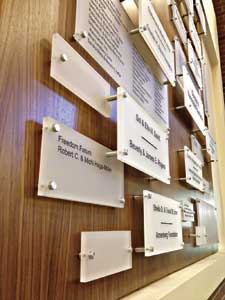There can be a tendency to take standoffs and other mounting hardware for granted; they are the underdogs and the unnoticed among acrylic and glossy finishes. But really, what would our exhibits, identity signage, and even P-O-P displays be without the aid of elegant, refined standoffs?
A recent installation at the Reno/Tahoe International Airport in Reno, Nevada colorfully and creatively demonstrates this point.
The airport’s Nevada Mining display is an interactive piece that shows how materials mined in Nevada are beneficial to air travel. It was built in-house by the Gyford StandOff Systems woodshop with photography and graphics provided by Dennis Long, founder and owner of TapWire Design in Carson City, Nevada. A total of twenty 1-1/4-inch-diameter security-style clear anodized aluminum cap stand-offs were used to mount the materials in place and make this exhibit “pop” even more.
But to emulate the success of projects such as this one, it’s important to get a good idea of the different type of stand-offs and how they can be utilized in signage projects.
Standoff caps come in round, square, or hexagonal shapes and are made of aluminum or stainless steel.
Standoff barrels (also referred to as “spacers”) are used to create a layering or three-dimensional effect, which works well with artwork or even to mount glass over another surface.

Standoff hubs, also referred to as four-way hubs, are installed between a cap and barrel, allowing material to be held at 90-degree intervals.
Grippers are used for mounting signage vertically or horizontally, from all sides or just one.
Finally the standoff link and traveler add attachment points to a project.
If you want to start with the basic standoff, consider the traditional cap-and-barrel system. “A barrel mounts to a wall or other surface and has a stud that penetrates the sign,” says Michael Eddins, manager of internal operations for Gyford StandOff Systems. “A cap is screwed onto the stud to complete the mount.
“If you don’t want to penetrate the sign, grips ‘grab’ the sign from the edges without penetrating the material and allow for easy removal and re-installation when needed.” (Note: Eddins adds that this might be a good choice for sales or promotional signage that needs to be changed frequently.)
Anodized aluminum is used for indoors, but stainless steel or powder-coated aluminum is the best choice for outdoor projects (and opens the door to an almost unlimited range of colors).
And while it may appear that standoffs look quite standard, when it comes to sizing and other customizing, there are some creative possibilities.
Standoffs can be sized in diameters as small as one-quarter of an inch to as large as two inches. Lengths, says Eddins, can range from one-quarter-inch to twelve inches.
There are even ways to display standoffs creatively. One such approach is a stacked panel system where elements of the sign are displayed in multiple overlapping levels, adding depth to the sign. “This look is achieved by using a system of multiple standoffs in various sizes, layering one level on top of the next,” says Eddins.
He points to a recent large-sized art display installation featuring a number of different elements for the Long Beach Convention and Entertainment Center in California. One-and-a-quarter-inch caps with various barrels ranging from 1/2-inch to 12 inches were featured in this install of various-sized acrylic panels attached to cut-aluminum pieces.
“The facility wanted to create an eye-catching display that wouldn’t add any complications for the installers,” says Eddins. “For this stacked solution, they had to take into consideration the cumulative weight of the panels on each connection point, as well as the surface anchors for load weight.”

According to Eddins, the stacked elements employed here generated more excitement about the display. “The viewers tend to pay more attention to the ‘forward’ elements and view the display for a longer period than they would a standard two-dimensional sign,” he says.
By Lori Shridhare
Photos: Gyford Standoff Systems.











